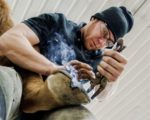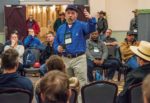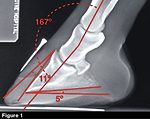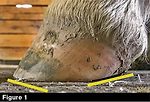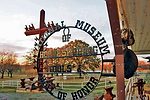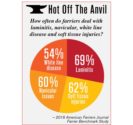Advertise Follow Us
American Farriers Journal

View Archived Issues
March 2019
Volume: 45
Edition: 2
American Farriers Journal is the “hands-on” magazine for professional farriers, equine veterinarians and horse care product and service buyers.
-
Table Of Contents
Table Of Contents
Understanding Hoof Shape
This is an extract from Chapter 3 of The Hoof of the Horse by Simon CurtisRead MorePreventing and Managing the Most Common Form of Laminitis
Strategies are improving to keep horses more comfortable and limit the progression of the deadly diseaseRead MoreShoeing For A LivingBuilding Upon a Strong Foundation
New York farrier Kalam Blessing focuses on improving horses’ lives by improving his skill setRead MoreCan a Conformational Deformity be Corrected or Maintained?
The answer lies in whether the conformational problem will return or worsen if regular farrier visits endRead MoreHow Ground Surfaces Influence Performance Horses
Research team examines how footing can help and hinder equine athletesRead MoreSuccessful Summit Educates and Inspires Hundreds of Farriers
The International Hoof-Care Summit drew hundreds of attendees to Cincinnati for education, networking and fellowshipRead MoreHoof-Care Professionals Get Ideas to Improve Their Everyday Work
Roundtables provide an opportunity to learn tips and techniques and apply them in their practiceRead More6 Honored for Lifetime Hoof-Care Accomplishments
Three farriers and three veterinarians were elected to their respective Halls Of Fame at the 2019 International Hoof-Care SummitRead MoreStep-By-Step System for Using Radiographs to Affect Shoeing
Presented at the 2018 Northeast Association of Equine Practitioners Seminar, Stefan Wehrli shares his protocol for transferring what he sees in X-rays to his shoeingRead MoreSteven Beane Wins Summit Mail-In Exercise
Concave challenge tests competitors, while delivering a practical shoe for many practicesRead MoreUse Caution When Using Radiographs for Farriery
Small mistakes can lead to big inaccuracies when capturing imagesRead MoreHow to Deal with Softhearted Clients and Spoiled Horses
Farriers offer advice on how to break bad habits of both owners and horsesRead MoreShoeing Tips from the Winter 2019 Anvil Brand Clinic
Farrier Hank Chisolm and equine veterinarian and farrier Brian Beasley share tips on shoeing for soundness and using adhesives, respectivelyRead MoreShoeing Principles for Club Feet
For veterinarians and farriers to properly address club feet, early intervention is the keyRead MoreAvoid These 3 Common Insurance Mistakes
Plus, find out when, what and how to insure your farrier practiceRead MoreHorseshoeing Museum Finds a New Home
Lee Liles’ Museum of Horseshoeing Tools is moving to the Oklahoma City StockyardsRead MoreResearch Journal: March 2019
The information, ideas and opinions expressed are those of the author and do not necessarily represent those of the United States Department of Agriculture.Read MoreFinal SayPersistence Pays Off In Navicular Case
Farrier struggles with a navicular case, but helps the Quarter Horse thanks to creative thinking, humbleness and owner patienceRead More -
Featured Articles
Featured Articles
Hoof-Care Professionals Get Ideas to Improve Their Everyday Work
Roundtables provide an opportunity to learn tips and techniques and apply them in their practiceRead MoreCan a Conformational Deformity be Corrected or Maintained?
The answer lies in whether the conformational problem will return or worsen if regular farrier visits endRead MoreShoeing Tips from the Winter 2019 Anvil Brand Clinic
Farrier Hank Chisolm and equine veterinarian and farrier Brian Beasley share tips on shoeing for soundness and using adhesives, respectivelyRead More - Digital Edition
-
Online Extras
Online Extras




